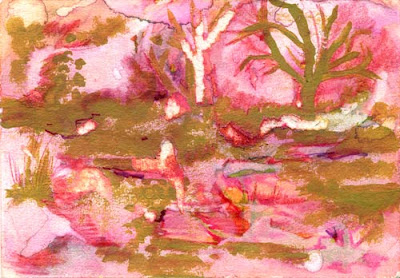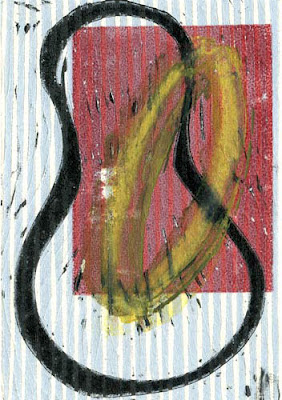(To learn more about the “Viewfinder Project” see the original post.)
Sometimes it is difficult to have a clear view or perspective. One’s mind may be so clouded with thoughts and worries that it is hard to stop and see what is immediate in front of oneself. Relief from this overly stimulated mind may include meditation techniques which center a person in the present. Art making can also shift a persons attention toward specific tasks and away from an overwhelming sense. Creative endeavors can lead to a sense of satisfaction brought about through focus, change, and invention. The key is to be engaged and to work. When doubt is set aside the results can be surprising.
For me, the following “Viewfinders” reflect these artists’ desire to work through problems in order to generate a less predetermined view. I say this because the layering of ink and paint in these examples point toward exploration rather than a succinct resolution. In the first two cases the work literally shows through to the other side of the paper
 |
| Eric Huebsch, Viewfinder, mixed media, 6in x 4 1/4in, 2006 |
Eric Huebsch shows a deftness when drawing a figure wearing rollerblades but the neck and head appear out of control (above). Not only is the neck elongated but I observe at least seven layers of media are used to create this part (e.g. ink, paint, collage,…). At the bottom is the statement “I knew you were no good”. Disturbing as this depiction may seems to be, I know some there is some “good”. No matter how painful a subject may appear the act of making art ultimately is a construction and an imagined representation that can become a focal point for dialogue.
 |
| Rebecca Vicars, Viewfinder, 4 1/4in x 6in, 2006 |
In the image above, Rebecca Vicars creates a view of a lush world full of growth. The description of space is loose and the painterly approach gives it the sense of a swampy wetland. A sense of control is tenuous; watercolor is applied here to provide unpredictable results. There has to be trust by the artist that through a committed effort the picture will come into focus.
 |
| Jennifer Peters, Viewfinder, monoprint, 2006 |
Jennifer Peters Viewfinder combines relief printing with what appears to be a monotype technique. The relief print requires carving to make a matrix that produces the print. What is carved here is premeditated, in the sense that the shapes are clearly defined, but how the shapes come together is less certain to me. The yellow marking, would make the final image a monoprint, was layered last as if to add an exclamation point. It seems to beg the question of when and what is too much? However, doing enough work to get to a point where this question becomes relavent is paramount.